new posts in all blogs
Viewing: Blog Posts Tagged with: Meg Rosoff, Most Recent at Top [Help]
Results 1 - 20 of 20
How to use this Page
You are viewing the most recent posts tagged with the words: Meg Rosoff in the JacketFlap blog reader. What is a tag? Think of a tag as a keyword or category label. Tags can both help you find posts on JacketFlap.com as well as provide an easy way for you to "remember" and classify posts for later recall. Try adding a tag yourself by clicking "Add a tag" below a post's header. Scroll down through the list of Recent Posts in the left column and click on a post title that sounds interesting. You can view all posts from a specific blog by clicking the Blog name in the right column, or you can click a 'More Posts from this Blog' link in any individual post.
On October 31, 2015, at 12:06 PM, author Meg Rosoff posted a comment to Roger Sutton's Facebook wall (he is the editor at Horn Book) that said "Debbie Reese is at it again." I wondered what "at it" meant and asked her, there, what she meant. (She didn't reply.)
Roger's post at Facebook is, essentially, a link to his editorial at the Horn Book website. Because the editorial is about diversity and meaningful inclusion of characters who are from marginalized populations, I assumed Rosoff's "at it again" was a reference to my question about her use of the word "squaw" in her book Picture Me Gone, and a reference to more recent critiques I've done of The Hired Girl and A Fine Dessert. (She subsequently wrote about critiques of those two books.)
Rosoff did not reply to my question. She did continue to participate in the ensuing discussion, however. I don't know if she didn't see that I was in it, too, asking her a question, or if she was deliberately ignoring me. In her next comment she said, in part
Doesn't anyone find it odd that so many of the books Debby Reese and her followers attack for "micro and macro aggressions" are on the prize lists for best books of the year? [...] Funny how much time we YA writers spend in schools talking to kids about the corrosive effects of bullying, and then to discover the worst bullies of all in our own community. The strongest backlash, by the way, is coming from editors. Who tell me they are backing away from publishing books featuring diversity characters/stories in order to avoid attacks for "micro and macro aggression." That's a result, then.
A short while later, Roger wrote that he was not "joining in the debate" because he counts me and Rosoff as professional friends and valued colleagues. She
replied to him:
Your professional friend and valued colleague has accused me repeatedly in public of being a racist and an enemy of diversity. I can wait very patiently for an apology on that score.
I was surprised by her comment. I have not accused her of being a racist. Nor have I called her an enemy of diversity. I was curious, however, to know why she thinks I did.
As that thread continued, I began to see her commenting elsewhere. I was surprised to see her referencing me so much saying things like "I know all about Debbie. She loves calling people racist" and "There are some very toxic so-called diversity advocates out there." I saw that she coined a phrase using my name: "The Debbie Reese Crimes Against Diversity stormtroopers." (Note: I was intrigued by what she was doing, and glad she was using my name, because it would lead people to my work. See, too,
my post on her use of "stormtroopers.")
And then I saw
this:
The extraordinary woman was the one who proved I was a racist by the use of the word 'squaw' in one of my books -- by an 11 year old English child. I had to look it up to realise it is sometimes (not always) considered insulting -- particularly if you're mainly reading to be insulted. I've written 600,000 or so words in my career and that's what she's taken out of it. Impressive.
Obviously, I am that extraordinary woman. Rosoff doesn't know, however, that when I picked up her book,
Picture Me Gone, it was to read for pleasure. I primarily read books that are specific to my area of scholarship and expertise (depictions of Native people) but I read for pleasure, too, and usually seek out books that have done well. That's why I was reading
Picture Me Gone. I was into it, too, but then, I got to this part:
A painting in a big gold frame of an Indian squaw kneeling by a fire needs dusting.
I stopped reading. The enjoyment, for me, was over. I set the book aside. I didn't blog or tweet about her use of "squaw." I just stopped reading it.
When
she jumped onto Edi Campbell's Facebook page on October 10th, I remembered her book. What she said on Edi's page prompted a lot of people to write to her on Facebook and on Twitter. In response, she wrote:
God, twitter makes me laugh. Book I'm finishing now for Mal Peet is about a black kid in love w/a native American woman 15 years his senior.
I was angry at her for what she said on Edi's page, especially because Edi's post was about
Large Fears by Myles E. Johnson and Kendrick Daye, a book that is about a queer black boy. Edi Campbell, Myles E. Johnson, and Kendrick Daye are three people trying to do some good in the world, shining bright lights on populations that are misrepresented and underrepresented in children's literature.
And there was Meg, like a ton of bricks, out of the blue. From that angry space, I replied to her tweet by asking her if she was going to use "squaw" to refer to that "native American woman." Here's a screen cap:
She didn't reply, but as her comment above indicates, she did not know the word is "sometimes (not always) considered insulting." As she said, she's written 600,000 words in her career, and she's impressed that out of all those words, I'm choosing to focus on one of those 600,000 words.
She is right. I am focusing on that one word as symbolic of the ongoing misrepresentation of Native peoples in children's and young adult literature. But I did not call her racist there, or anywhere.
My focus is on Meg Rosoff's response to being questioned. Her response about the word admits that she didn't know it is problematic. There is a way to respond to ones ignorance that can move children's literature forward in its depictions of those who have been omitted and misrepresented for hundreds of years, but Rosoff's dismissal and subsequent comments disparaging me are not the way to move forward.
Her response stands in sharp contrast to the response
Emily Jenkins posted yesterday, in response to criticisms about the depictions of slavery in
A Fine Dessert, and it stands in sharp contrast to Sarah McCarry's response to my question about
her use of "totem pole" in
All Our Pretty Songs. Some people are rising to defend Rosoff. Some are defending Jenkins and Blackall, too. Some of them know Rosoff, Jenkins, and Blackall personally, and feel--as they should--empathy for people who they feel fondly towards.
But!
Teachers and librarians are forgetting that their primary responsibility as educators is not to an author or illustrator they like, but to the children in their classrooms. As parents, we trust you to do right by our children and what they learn from you. What you give them is something they will carry with them as they grow up.
The larger point of what I'm saying is that people of marginalized populations are using social media to ask questions. We are using social media to shine lights on problems that our children grandchildren are confronted with everyday, in and out of the classroom.
The country is growing more diverse with each minute. What you do in the classroom matters to the future of our country. That cliched bumper sticker that teachers touch the future is more than a cliche. It is a fact. Expand how you think about that future. We're all here, talking to you, and hoping you'll pick up the lights we shine, too, and do right by the children you teach.
On October 31st, Meg Rosoff posted this to her Facebook page:
Rosoff has said a good many disparaging things about me that I'm ignoring. This one, I will not ignore.
Like millions of people, I love Star Wars. But Rosoff is wrong in calling those of us who point out stereotyping, bias, and misrepresentations "stormtroopers." She's trying to cast us as evil for what we do. She is equating us with Nazi stormtroopers.
We're not bad guys. As Rene Saldana said, he thinks of me as a Jedi Knight. Lot of people said they want to make t-shirts with Rosoff's phrase on them, but we say who we are.
Let's do something like this instead:
Jedi Knights in Solidarity:
Fighting Crimes Against Diversity
or how about...
Jedi Knights in Solidarity:
Fighting Ignorance, One Rosoff at a Time*
There's a lot of writers doing this work! I'd love to see what you come up with! Adding graphics...
________________
*I said "fighting ignorance" because Rosoff said she looked it up and did not know the word "squaw" is, quoting her: "sometimes (not always) considered insulting."

By:
Debbie Reese,
on 10/28/2015
Blog:
American Indians in Children's Literature
(
Login to Add to MyJacketFlap)
JacketFlap tags:
Debbie's lectures,
The Hired Girl,
Walk On Earth a Stranger,
Picture Me Gone,
A Fine Dessert,
Della Nohl,
Omar Poler,
Meg Rosoff,
Best Books,
Betsy Bird,
Chicago Public Library,
Add a tag
I am pleased to be the keynote speaker at the Chicago Public Library, Edgewater Branch, on November 7, 2015, as the library system there kicks off its programming for Native American Heritage Month.
Della Nohl took that photo of me a few years ago when we were both at a
Culture Keepers gathering. Do hit that link and see what Culture Keepers is all about. You'll learn a lot about working with Native people and you'll come to know people like Omar Poler of the
Sokaogon Chippewa Tribe of Wisconsin, who was
named as one of Library Journal's Movers and Shakers in 2014. And, check out
Della Nohl's page. Right now (October 28, 2015) the photo at the top of her page is of the Indian Agency House in Portage, Wisconsin.
Knowing about Culture Keepers and knowing about Della Nohl's work is part of my world. Earlier today, I submitted a comment to
Betsy Bird's blog post at
School Library Journal. There, she is making the argument that people have to read a book in its entirety to say anything meaningful about the book. I disagree.
I don't, for example, need to read every page of Meg Rosoff's
Picture Me Gone to say I don't recommend it. My reason? I got to the page where her main character is in a coffee shop with unusual decor. As her character looks around, she describes what she sees, including:
A painting in a big gold frame of an Indian squaw kneeling by a fire needs dusting.
Rosoff's
Picture Me Gone is not about Native people. It is, however, a best selling book, and part of what I do is read some of those bestsellers so that I stay abreast of the happenings, so to speak, in children's and young adult literature.
Rosoff used "Indian squaw" -- a term most people view as offensive. Did Rosoff know it is offensive? Did Rosoff's editor know it is offensive? My guess is no. I speculate that they don't know because they don't step over into the world that I am in.
So many Native children don't do well in school. Might they do better if the textbooks they read were ones that honestly presented their nations, past and present? Might they do better if they didn't come across terms like "squaw" as a matter of course, in the literature they read?
As I write this blog post and think about what I'll say in Chicago, I'm thinking about Rosoff's book, and I'm thinking about troubling books that are being discussed as possible winners of prestigious children's literature awards: Laura Amy Schlitz's
The Hired Girl and Emily Jenkins and Sophie Blackall's
A Fine Dessert troubling. And Rae Carson's
Walk On Earth a Stranger has, perhaps, some of the most damaging content that I've seen in a very long time. It was on the long list for the National Book Award.
I do--of course--know of some terrific books that accurately and beautiful present Native peoples, and I will share those, too, on November 7th. I shared some--
for teen readers--in a column that went live a few hours ago at
School Library Journal. And I shared even more, there, two years ago. Here's the graphics SLJ's team put together, using the book covers for the books I recommended in that column:
My guess is that people who come to my talk on the 7th will be people who care about Native peoples, our histories, our cultures, and our lives. They will likely want me to talk about good books. It isn't enough, however, to know about books that accurately portray who we are; people have to know the others, too, because in the publishing world, they take up a lot of space.
Please put this day of events on your calendar! Bring your friends! Step into my world, and help me bring others into it, too, so that the status quo changes... So that best selling writers and books deemed worthy of awards are not ones that denigrate Native people.
Below is the press release Chicago Public Library is sending out.
_____________________
CHICAGO PUBLIC LIBRARY CELEBRATES NATIVE AMERICAN HERITAGE MONTH IN NOVEMBER
FOR IMMEDIATE RELEASE
October 20, 2015
Chicago Public Library is "Celebrating Diversity," with its annual observance ofNative American Heritage Month. Throughout November, the Library offers a variety of programs highlighting the history, culture, traditions, and contributions Native Americans have made to Chicago, the state of Illinois, and to the U.S. In addition, a selected bibliography and the Library’s 2015 Native American Heritage Month Calendar of Events are available at chipublib.org.
The opening program for Native American Heritage Month takes place on Saturday, November 7, at 11:00 a.m., at the Edgewater Branch, 6000 N. Broadway St. Debbie Reese, author, lecturer, and blogger will be the keynote speaker. Ms. Reese is tribally enrolled at Nambe Pueblo and has a PhD in Education from the University of Illinois and an MLIS from San Jose State University. Her research articles and book chapters on American Indians in Children’s Literature are used in Education, Library Science, English, and Creative Writing courses in the U.S. and Canada. Andrea Perkins and the Chi-Nations Youth Council will provide drum performances. A film screening of, From Old to Modern, which focuses modern activism will also be presented by the Chi-Nations Youth Council.
During Native American Heritage Month, the Library will present interesting, entertaining and informative programs for all ages, including storytelling and crafts for children, lectures, film screenings, art exhibitions and workshops, and adult book discussions.
Here are some highlights from the 2015 Native American Heritage Month Celebration:
Al Eastman, a certified archery coach with the Olympic Committee’s USA Archery program will teach the ten-step form of safety techniques for a hands-on archery demonstration with Olympic-style recurve bows. Eastman started the archery program at the American Indian Center in 2010 to help youth learn about math, science and history through archery.
- Ehdrigohr: A Role-Playing Experience
Allen Turner, creator of Ehdrigohr—a table top role-playing game—will present this fun and challenging game that incorporates Naïve American themes. Turner has been involved in storytelling, games, play design, and education for most of his adult life. His work includes coordinating youth and adult programs focusing on literacy, storytelling, role-playing, and team dynamics for developing inference and problem-solving skills.
Artist and musician Dan Pierce will explore the meanings Dreamcatcher components and instruct participants in how to use materials to craft Dreamcatchers that they can take home. Pierce has taught music and art in the Chicago Public Schools for more than 20 years.
The Library presents five selected feature films spotlighting Native American culture including:
· The Exiles by Kent Mackenzie
· Up Heartbreak Hill by Erica Scharf
· Sun Kissed by Maya Stark and Adi Lavy
· In the Light of Reverence by Christopher McLeod and Malinda Maynor
· Stand Silent Nation by Suree Towfighnia and Courtney Hermann
For more information about the film series, or for the complete listing of Native American Heritage Month events, dates and locations, please visit chipublib.org.
Throughout every calendar year, Chicago Public Library “Celebrates Diversity” and its importance to a sustainable society, during all of its ethnic heritage and diversity month celebrations including: African-American History Month, Women’s History Month, Asian and Pacific Islander Heritage Month, LGBT Pride Month, Hispanic Heritage Month, Polish American heritage Month and Native American Heritage Month.
As most people in children's literature know, Laura Amy Schlitz's book, The Hired Girl, has been the focus of a great deal of discussion over the last two weeks. That discussion is primarily centered on her use of "civilized" to describe Indians, and, her depictions of Jews. The point of view in The Hired Girl is a 14 year old girl who is Roman Catholic. Her name is Joan.
Today, I am taking a look at a passage in The Hired Girl that has bearing on heated discussions of late about diversity and "who can write." Meg Rosoff's comments on Edith Campbell's Facebook page and Michael Grant's post are two recent examples of the discussions, and I think Schlitz, through her character, is chiming in, too, in the later part of her book.
David, a Jewish character in The Hired Girl, has his heart set on being a portrait painter. He doesn't want to take up a position in his father's department store. He wants to study painting in Paris. He is working on a painting of Joan of Arc, for a French woman named Madame Marechaux. A devout Catholic, Madame Marechaux wants to see Joan of Arc made into a saint and wants to hang a large painting of her at the top of her stairs in her house on Fifth Avenue in New York City. If his painting is chosen, David thinks it will help him in his dream of being a painter. He asks Joan to sit for him because he thinks her physique and her face, are like that of Joan of Arc.
Well, Madame Marechaux does not choose his painting. She chose the painting done by a French painter named LeClerq. David tells Joan (Kindle Locations 4253-4259):
“The wretched woman chose LeClerq! LeClerq, can you imagine? Of course you don’t know LeClerq, but he’s an idiot! He can’t draw, his perspective’s faulty; he couldn’t foreshorten if his life depended on it. All he does is slather on a lot of greasy impasto with a palette knife — it’s sickening; the man’s a fake, but he’s French, which makes him a god to Madame Marechaux, and he’s not a Jew —”
“The way he carries on about religion, you’d think he was Beato Angelico. Oily little highlights everywhere; it’s enough to make you sick. Madame Marechaux said his sketches were imbued with the deepest piety. Can you imagine saying that — imbued with the deepest piety? Did you ever hear anything so pretentious in your life?”
In the first paragraph, note how LeClerq's abilities are denigrated. In the second one, his speech about his religion (Roman Catholic) is also denigrated--especially in how it informs his art. David continues (Kindle Locations 4265-4268):
She says that I’m bound to be at a disadvantage with Joan of Arc because I’m not a Roman Catholic. What does she know about it? When I’m painting, my religion is painting! I could paint Mahomet flying into the sky on a peacock, or a jackass, or whatever the hell it was. I could feel it, I swear I’d feel it, I’d be imbued with the deepest piety —”
Two things come to mind. Muslims do not depict Muhammed. People depict him anyway, and use free speech as a defense of their decisions to depict him. What is being communicated to readers through David's words?
Is Schlitz--through her characters--pushing against the growing call for diversity of authors? I think so, and, I think it is an overt move on the part of Schlitz, her editor, and her publishing house.
What do you think?

By:
Betsy Bird,
on 10/12/2015
Blog:
A Fuse #8 Production
(
Login to Add to MyJacketFlap)
JacketFlap tags:
Bookie Woogie,
Harold and the Purple Crayon,
Sandra Boynton,
Fusenews,
librarian stereotypes,
book jewelry,
independent bookstores rule,
dead blogs,
Meg Rosoff,
children's bookstores,
Book Art,
Alice's Adventures in Wonderland,
Peanuts,
Add a tag
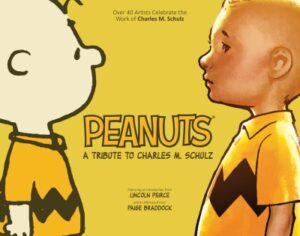 I mention to folks that in my new job I actually don’t work day-to-day with children’s books all that often anymore and they wonder how I’m coping. As it happens, I’m just ducky. Since my spare hours are just as chock full of kidlit as before, I honestly don’t feel like I’m missing too much. I still read my reviews and get my galleys. But occasionally something will be published and I’ll be hit by an overpowering wave of self-pity. This week’s, “Why Didn’t I See That?!” kvetch-fest? Peanuts: A Tribute to Charles M. Schulz by Charles M. Schulz, illustrated by Matt Groening, Raina Telgemeier, and Jeffrey Brown amongst MANY others. And it’s a 2015 title at that. Waaaaaaaant.
I mention to folks that in my new job I actually don’t work day-to-day with children’s books all that often anymore and they wonder how I’m coping. As it happens, I’m just ducky. Since my spare hours are just as chock full of kidlit as before, I honestly don’t feel like I’m missing too much. I still read my reviews and get my galleys. But occasionally something will be published and I’ll be hit by an overpowering wave of self-pity. This week’s, “Why Didn’t I See That?!” kvetch-fest? Peanuts: A Tribute to Charles M. Schulz by Charles M. Schulz, illustrated by Matt Groening, Raina Telgemeier, and Jeffrey Brown amongst MANY others. And it’s a 2015 title at that. Waaaaaaaant.
- Meanwhile, another very cool looking book was recently released. Jules at the Kirkus version of 7-Imp has the skinny on The Complete Alice a.k.a. what you can get me for Christmas.
- I think I could be happy if I just spent the rest of my life reading snarky reviews of that darn rabbit book. First there was Travis. Then Roger. And yes, I know that the more we talk about the bunny monstrosity the more time it will take before it goes away. But we have such a lovely literary community there of mutual appreciation that when we are actually allowed to dislike something, it has a tendency to go to our heads. Wascally wabbit.
- Sure, they’re a mammoth publishing entity of massive production and countless staff but . . . awww. Look what Harper Collins did for Harold’s birthday. Ain’t it sweet?
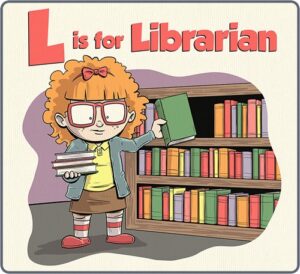 Hmm. Sounds good at first. The headline reads, “Tired of stereotypical characters in books for girls, this dad wrote his own.” Then it shows a book of various professions helmed by women in an abecedarian fashion. It’s no Rad American Women A to Z but it’ll do. Except . . . when you get to “L”. I don’t generally get all hot under the collar when folks stereotype my profession, but COME ON, MAN. Shoot, it’s images like that that kept me out of the profession in the first place.
Hmm. Sounds good at first. The headline reads, “Tired of stereotypical characters in books for girls, this dad wrote his own.” Then it shows a book of various professions helmed by women in an abecedarian fashion. It’s no Rad American Women A to Z but it’ll do. Except . . . when you get to “L”. I don’t generally get all hot under the collar when folks stereotype my profession, but COME ON, MAN. Shoot, it’s images like that that kept me out of the profession in the first place.
- File this one away in the It Isn’t Just Me drawer. Some of you may be aware that before I post an episode of Fuse #8 TV, a series where I interview authors and illustrators in a free and easy manner, I always begin with a bit of “Reading (Too Much Into) Picture Books”. This is a series where I acknowledge (without actually saying outright) that when a parent reads a picture book too many times to a small child, they start to conjure up some pretty crazy theories about the text. Well, thanks in large part to a recent New Yorker profile of Sandra Boynton by Ian Bogost, I see that I am not alone. I’m actually in awe of his take on But Not the Hippopotamus. The North America vs. Africa vs. Central America theory? Brilliant! By the way, my most ambitious re-interpretation will preface my Fuse #8 TV episode this coming Thursday. Be prepared for a truly wacky one.
- Okay. That’s it. No one’s allowed to quit their blogs anymore. I like the blogs that I like. I may not check them every day but I like the reliability of visiting them and seeing something new. And I get very sad indeed when the best ones fall by the wayside. I mean, let’s say someone walked up to you and asked, “What’s the best children’s literature blog where real kids review real books . . . and it’s fun to read?” You would answer without hesitation (if you were me, that is), “Aaron Zenz’s Bookie Woogie blog, of course!” Well, here’s the thing. The blog? It’s had a nice run. Seven years worth, in fact. And now it’s done. Over. Kaputski. And we’re all just a little bit sadder today. *sigh*
- Me Stuff: First off, I want to bow down low and thank profusely all the folks who came out for my joint SCBWI-IL/Center for Teaching through Children’s Books welcoming party last week. It was, without a doubt, the BEST welcome party I have ever had, bar none. I even signed someone’s cookie (that’s a first!). If you live in the Chicago area and missed it, never fear. You could come on out to EPL and see me present on the topic of picture books rather soon. Yes, the very kind and talented Brian Wilson has allowed me to join him on his annual Best Picture Books Presentation. I’ll get to talk about some of my too little lauded favorites of 2015, which is just a joy. Finally, Chicago Magazine interviewed me recently. They’re using the same photo from my Chicago Tribune interview, which is confusing, but the talk is entirely different. It was awfully fun to do too.
 In my interview I actually mention The Guinness Book of World Records a fair amount. Rather appropriate since I recently learned that the book Farmer Will Allen and the Growing Table has been selected by the Points of Light Foundation as the book to break Guinness World Record for the number of children being read to in a 24-hour period. Part of the Foundation’s “Read Across the Globe” initiative to raise awareness on the global literacy crisis, volunteers all over the world will read the book next Monday, October 19. Here’s a news article and a tv news report that say more about it. Thanks to Philip Lee for the links.
In my interview I actually mention The Guinness Book of World Records a fair amount. Rather appropriate since I recently learned that the book Farmer Will Allen and the Growing Table has been selected by the Points of Light Foundation as the book to break Guinness World Record for the number of children being read to in a 24-hour period. Part of the Foundation’s “Read Across the Globe” initiative to raise awareness on the global literacy crisis, volunteers all over the world will read the book next Monday, October 19. Here’s a news article and a tv news report that say more about it. Thanks to Philip Lee for the links.
- Did you see? They’re releasing Amazing Grace by Mary Hoffman. Wouldn’t be particularly notable aside from the fact that it’s always nice to see diverse books back in print . . . except something’s a bit different from the last time it was printed. Did you notice what it was? Debbie Reese most certainly did.
- In case you missed it (like me) there was a new brouhaha last week. This time it involved author Meg Rosoff. There’s a recap over at Reading While White which breaks it down. Aren’t recaps great? There should be more of them out there these days.
- Each year I try to write a review of at least one self-published book. It can be a tricky affair since so many of them make common missteps. That’s why I really appreciated the ShelfTalker piece When a Self-Published Book Is Done Right. There really are some great ones out there. Finding them is often the struggle, but when they work, they work.
- By the way, I just want to give a shout out to The Curious Reader Store over in Glen Rock, NJ. My buddy Tucker Stone was recently there and he mentioned that they had a particular love for Wild Things there. Thanks, guys (but particularly Sally)! We do appreciate it.
The title of this piece is 15+ Book-Inspired Pieces Of Jewelry For Bookworms, which you’ll see is a bit of a stretch. Still and all, I do like these Labyrinth earrings:


Last night, friend and colleague Edith Campbell's page on Facebook had a visit from writer, Meg Rosoff, who objected in shameful ways to calls for diversity. Rosoff said kids who are looking for representations of themselves should "read a newspaper" and that people calling for diversity should "write a pamphlet" about it. She said that books don't have agendas. She said a lot of things.
Edi wrote it up at her site. Go read it. It sparked a great deal of conversation on Twitter.
Are you wondering what Rosoff's response to all of this is? Here you go:
God, Rosoff, you are something else. Last year, I started to read her
Picture Me Gone. It was on the short list for the National Book Award. I got to this part and quit reading:
"Indian squaw"? At that point in
Picture Me Gone her characters are in a cafe. Items on the wall are what look very old. She didn't need that line about that painting in her book. Removing it wouldn't change the book at all. Having it there, however, is a microaggression. She's using a slur.
I wonder what words she uses to describe that "native American woman" in her next book? I have lots of questions about that plot. Why is the black kid in love with that woman? What is her nation? What is her name?
She hasn't written characters like this before. My guess is she's trying to cash in on the call for diversity. But, as her remarks on Edi's page show, she is no ally to the call for diversity.
I'm hitting the upload button on this post. I may be back with updates...
By:
Guest Posts,
on 3/18/2014
Blog:
The Children's Book Review
(
Login to Add to MyJacketFlap)
JacketFlap tags:
Music,
Writing Resources,
Ages 9-12,
Dance,
Picture Books,
Meg Rosoff,
Writing,
Toni Morrison,
Author Interviews,
John Green,
Emily Dickinson,
Dancing,
Books for Girls,
Dave Eggers,
Christian Robinson,
E. B. White,
Jesmyn Ward,
Cultural Wisdom,
NoViolet Bulawayo,
Josephine Baker,
Patricia Hruby Powell,
Jeanette Winterson. M.T. Anderson,
My Writing and Reading Life,
Uyen Nicole Duong,
Add a tag
Patricia Hruby Powell danced throughout the Americas and Europe with her dance company, One Plus One, before becoming a writer of children's books. She is the author of Josephine: The Dazzling Life of Josephine Baker, an extraordinary portrait of the passionate performer and civil rights advocate Josephine Baker written in exuberant verse. She lives in Champaign, Illinois. You can visit her online at talesforallages.com.
The SCBWI NY conference was incredible. There just is no other word for it. The staff was very helpful and I was impressed at how smoothly everything ran. They provided delicious breakfast breads and coffee (!!!!) each morning and the cocktail party was stunning and so yummy. I ate way too much of that sweet potato dish.Here's a picture of me with Kit Grindstaff and Ruth Setton at the social.I took tedious notes throughout the conference and if you followed the Twitter hashtag #NY13SCBWI you'll find my brief comments along with many others. Here's a picture of my MiG crit partners: Andrea Mack, Susan Laidlaw, Kate Fall and Carmella Van Vleet. So fun hanging out with them!I found the conference inspiring, and within it, many gems of wisdom that I can use in my own writing. Some brief thoughts thoughts of the weekend:Meg Rosoff had some great things to say about writing for children and to not get discouraged when others ask: "When are you going to write a real book? Like for adults?" She also encourages writers to: "Be flexible"For my breakout session, I went to Molly O'Neil- she's encourages writers to write with authenticity and heart. Here's the line of books that Molly has edited.Next I went to hear Francoise Bui because of her focus on characterization. Her three points were to build great characters you need voice, characterization and texture with in the story.
Shaun Tan, an illustrator, spoke about the importance to not fear failure. This helps us to be free to create and experiment. Knowing that you can throw out your work allows you to be uninhibited to create. I just loved that.Margaret Peterson Haddix reminded us that we must write a book for the kid that doesn't like to read. If we can do that, then the kids who do like to read will love it, too.Julie Andews spoke with her daughter, Emma Walton Hamilton. I was amazed by Andrew's presence, which seemed to fill the entire room. The two of them talked about brainstorming and then plotting since they need to work with each other to get the job done. They use a web cam for most of their writing sessions. Since they write multiple books in a series, they realized they needed to keep the books balanced between the inevitable and the element of surprise, which can be tricky.Finally, Mo Williams raced to the podium and then around the room. He was great and I laughed so hard hearing him speak. Williams urged us to go deeper, write what we don't know and understand so that we can explore new emotions within ourselves. He also said to not be afraid to ask the tough questions. Here's a link of great advice on Mo's 9 steps of writing.Oh, and I loved this line Williams said, "Writing is like a sale at the Gap. Take off 20%!"Such a great experience. I would highly recommend this conference!
.jpeg?picon=2287)
By: Martha Brockenbrough,
on 2/3/2013
Blog:
The Official SCBWI 10th Annual New York Conference Blog
(
Login to Add to MyJacketFlap)
JacketFlap tags:
Mo Willems,
Meg Rosoff,
Shaun Tan,
Jane Yolen,
Margaret Peterson Haddix,
mark teague,
Floyd Cooper,
David Ezra Stein,
Arthur A. Levine,
autograph party,
matthew kirby,
#NY13SCBWI,
Add a tag
Almost the moment Mo Willems' keynote speech ended, people started lining up to get their books signed and we kid you not, the line ran the length of a football field (that's 100 yards, for those of you unfamiliar with the sport, or 91.44 meters if you're Canadian).
It's no wonder people are so excited to have their books inscribed, when you share the room with the likes of Julie Andrews, Mo Willems, Shaun Tan, Jane Yolen, Tomie dePaolo ...
We could and should go on, but we'll let the pictures speak for themselves.
 |
| Mo Willems |
 |
| Shaun Tan fans standing in a queue (do they say that in Australia?) |
 |
| Shaun Tan |
 |
| Mark Teague and Floyd Cooper |
 |
| Meg Rosoff and David Ezra Stein |
 |
| Lin Oliver and Theo Baker |
 |
| Tomie DePaola and Jane Yolen |
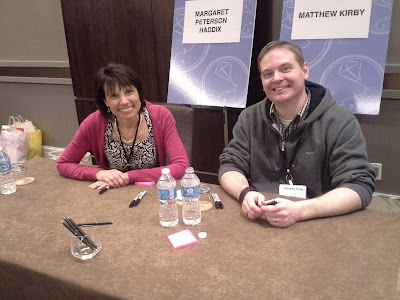 |
| Margaret Peterson Haddix and Matthew Kirby |
 |
Arthur Levine is a full-service editor. Here, he's opening
the book to the right page for an inscription. |
Meg Rosoff, the award winning author of THERE IS NO DOG, PICTURE ME GONE, and HOW I LIVE NOW (soon to be a feature film), is the opening keynote of the SCBWI Winter Conference. Which, by the way, has an amazing title: So When Are You Going to Write a Real Book, You Know, For Adults?
Meg is hilarious--starting off by uttering the words that many authors cringe when hearing: "If all else fails, I'll write a kid's book" or "If I had time, I'd write a kid's book." And then Meg mentioned some of the people she would punch in the face (if only in her imagination).
The entire room erupted in hysterical laughter as Meg read from such classics as IF ROAST BEEF COULD FLY by Jay Leno and FIFTY SHADES OF GREY by E.L. James.
Meg is a highly acclaimed author, but her journey is fascinating and inspiring. She talked of failure, of bad reviews, and of writing. Meg discussed the stigma that sometimes comes along with writing for children.



When asked by students about the best book she's ever read, Meg replies that the best books she's read were read before her twenties.
Because as a teenager, she was at the exact right age to have her life changed. Meg read from an email that she received from a reader, and it's the reason she writes for teenagers.
Some people think of young readers as lesser versions of adults. They don't get it. As an author, you must write truthfully. You shouldn't apologize for writing for teens or children! You're writing about the emerging people your readers will become. And you're changing lives.
When I was trying to call up the list of nominees for the Astrid Lindgren Memorial Award (
ALMA) for 2012, I came across this picture:
Which if you think about it is pretty much how you'd like to imagine the creator of Pippi Longstocking.
And here's Pippi as imagined by the wonderful
Lauren Child.
There's a great write-up on Lindgren
here.
But on to the prize - here's what the website has to say:
The Astrid Lindgren Memorial Award (ALMA) is the world's largest prize for children's and young adult literature. The award, which amounts to SEK 5 million, is awarded annually to a single recipient or to several. Authors, illustrators, oral storytellers and those active in reading promotion may be rewarded. The award is designed to promote interest in children's and young adult literature, and in children's rights, globally.
Lots of exciting names on the
nominees list (Canada is well-represented by writers Jean Little, Brian Doyle and Michel
Noël), but I was particularly pleased to see
Meg Rosoff's name. I'm a great admirer of Rosoff's work, but my particular favourite amongst her novels is
What I Was. You can read my review online at
In Identity Crisis? Not Really Meg Rosoff explains that whether or not her books are classified as YA or adult is determined by her publishers' marketing departments. "The truth is, most writers simply write, and by virtue of the subject matter they choose (divorce, sexual deviance, the Peloponnesian wars), are deemed to be adult writers. The presence of puppies and pigs in a story line usually indicates a children’s book, except when it doesn’t (Marley and Me, Animal Farm)."
I don't know about the Peloponnesian wars, but divorce and, if you define the term loosely enough, sexual deviance certainly turn up in YA.
I have control issues and Rosoff evidently doesn't, which is probably why she wrote How I Live Now, and I didn't. Just writing and letting the chips fall where they may as far as an audience is concerned has worked rather well for her. But to me, knowing whether I'm writing a children's, YA, or adult book is less about audience than it is about knowing what the hell I'm doing. Decisions must be made, people! How can I make decisions about character, voice, setting, theme, and plot, if I haven't made the fundamental decision about what I'm doing first?
Really. I'm feeling quite stressed thinking about this. Rosoff didn't sound stressed in that PW article, did she?
She had a couple of quite interesting things to say toward the end of the article:
You know how traditional wisdom says that kids' read up? Rosoff addresses that. '“In America, novels cross down,” one publisher told me' (Rosoff), “but they don’t cross up,” meaning teens will read adult books, but not vice versa.' Teens continue to read up. What do adults read up to? I've wondered about that before.
Rosoff also describes her new book What I Was as "a love story set in a boy’s boarding school in 1962, narrated by the main character as a very old man." She goes on to say, "In the U.K. it will have two editions. In the U.S., just one—adult."
My understanding of adult vs. YA/kid classifications is that if the narrator of a book is an adult looking back on his youth, than it is an adult book because the story is told through an adult sensibility. That adult has knowledge of what happened past the time in which the story takes place. A YA or children's book has a narrator telling a story of something happening to him in the moment and has no knowledge beyond the time of the story. So Rosoff's new book sounds adult to me.
I think Rosoff's article was meant to try to distance herself from the whole "YA or adult?" debate as far as her own books are concerned. While doing that, though, I think she may raise some questions for readers for whom YA fiction is defined by more than the people who read it.
Link came from the Adbooks listserv.





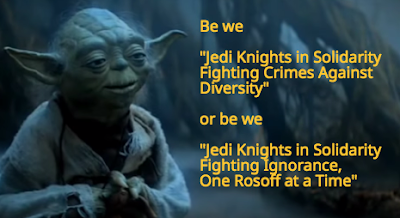
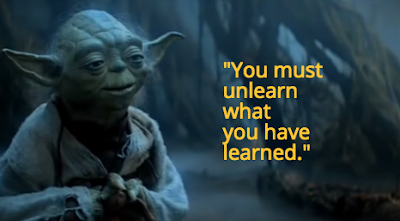
























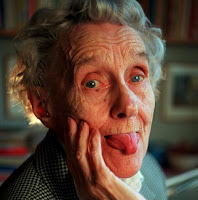


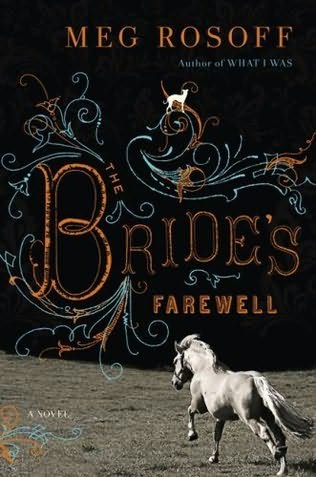
Wait — that’s ME! Thank you, Betsy – you’re a huge inspiration to me (honestly, it feels like the president just gave me a shout out during the State of the Union). And yes, we looooove Wild Things.
I am a huge Betsy Bird fan and an enormous Sally at The Curious Reader fan. Imagine my joy at seeing you both in the same place! Yay to book loving people loving each other!